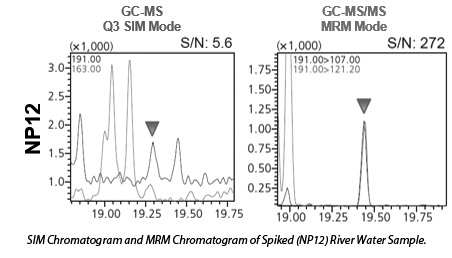In this application note, a method using a high selectivity triple quadrupole gas chromatography-mass spectrometer (GC–MS/MS) to detect for nonylphenol in river water is presented.
 Nonylphenol (NP) is a type of alkylphenol that has been identified as an endocrine disruptor; a compound that may alter the endocrine system, causing diseases in the human reproductive systems or feminization of an aquatic population. Despite these concerns, NP precursors are still utilised extensively in industrial activities and discharged into the wastewater plants and river water, where they can degrade into toxic NP. NP can also persist in the environment and bioaccumulation can occur, resulting in compounds of higher toxicity. Therefore, restrictions have been implemented by government organizations and NP levels in the environment are closely monitored to reduce environmental risk.
Nonylphenol (NP) is a type of alkylphenol that has been identified as an endocrine disruptor; a compound that may alter the endocrine system, causing diseases in the human reproductive systems or feminization of an aquatic population. Despite these concerns, NP precursors are still utilised extensively in industrial activities and discharged into the wastewater plants and river water, where they can degrade into toxic NP. NP can also persist in the environment and bioaccumulation can occur, resulting in compounds of higher toxicity. Therefore, restrictions have been implemented by government organizations and NP levels in the environment are closely monitored to reduce environmental risk.
 This highlights the requirement of a high sensitivity method to detect and quantify NP. In this application news, a method using a high selectivity triple quadrupole gas chromatography-mass spectrometer (GC–MS/MS) to detect for nonylphenol in river water is presented. Using this method, it was possible to detect for 13 nonylphenol isomers standard solutions at a concentration of 0.01 µg/mL. The method was also compared against conventional water analysis by GC–MS. The results showed that MRM mode optimization using GC–MS/MS improved sensitivity by fifty-folds for isomers (e.g., NP12) that were difficult to quantitate using GC–MS. This improvement was demonstrated even without complex cleanup procedures.
This highlights the requirement of a high sensitivity method to detect and quantify NP. In this application news, a method using a high selectivity triple quadrupole gas chromatography-mass spectrometer (GC–MS/MS) to detect for nonylphenol in river water is presented. Using this method, it was possible to detect for 13 nonylphenol isomers standard solutions at a concentration of 0.01 µg/mL. The method was also compared against conventional water analysis by GC–MS. The results showed that MRM mode optimization using GC–MS/MS improved sensitivity by fifty-folds for isomers (e.g., NP12) that were difficult to quantitate using GC–MS. This improvement was demonstrated even without complex cleanup procedures.




